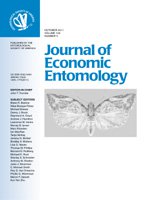Lesquerella, Physaria fendleri (A. Gray) S. Watson, is a mustard native to the western United States and is currently being developed as a commercial source of valuable hydroxy fatty acids that can be used in a number of industrial applications, including biolubricants, biofuel additives, motor oils, resins, waxes, nylons, plastics, corrosion inhibitors, cosmetics, and coatings. The plant is cultivated as a winter-spring annual and in the desert southwest it harbors large populations of arthropods, several of which could be significant pests once production expands. Lygus spp. (Hemiptera: Miridae) are common in lesquerella and are known pests of a number of agronomic and horticultural crops where they feed primarily on reproductive tissues. A 4-yr replicated plot study was undertaken to evaluate the probable impact of Lygus spp. on production of this potential new crop. Plant damage and subsequent seed yield and quality were examined relative to variable and representative densities of Lygus spp. (0.3–4.9 insects per sweep net) resulting from variable frequency and timing of insecticide applications. Increasing damage to various fruiting structures (flowers [0.9–13.9%], buds [1.2–7.1%], and seed pods [19.4–42.5%]) was significantly associated with increasing pest abundance, particularly the abundance of nymphs, in all years. This damage, however, did not consistently translate into reductions in seed yield (481–1,336 kg/ha), individual seed weight (0.5–0.7 g per 1,000 seed), or seed oil content (21.8–30.4%), and pest abundance generally explained relatively little of the variation in crop yield and quality. Negative effects on yield were not sensitive to the timing of pest damage (early versus late season) but were more pronounced during years when potential yields were lower due to weed competition and other agronomic factors. Results suggest that if the crop is established and managed in a more optimal fashion, Lygus spp. may not significantly limit yield. Nonetheless, additional work will be needed once more uniform cultivars become available and yield effects can be more precisely measured. Densities of Lygus spp. in unsprayed lesquerella are on par with those in other known agroecosystem level sources of this pest (e.g., forage and seed alfalfa, Medicago sativa L.). Thus, lesquerella production may introduce new challenges to pest management in crops such as cotton.
How to translate text using browser tools
1 October 2011
Impact of Lygus spp. (Hemiptera: Miridae) on Damage, Yield and Quality of Lesquerella (Physaria fendleri), A Potential New Oil-Seed Crop
Steven E. Naranjo,
Peter C. Ellsworth,
David A. Dierig
ACCESS THE FULL ARTICLE
It is not available for individual sale.
This article is only available to subscribers.
It is not available for individual sale.
It is not available for individual sale.

Journal of Economic Entomology
Vol. 104 • No. 5
October 2011
Vol. 104 • No. 5
October 2011
crop damage
Lygus elisus
Lygus hesperus
Lygus lineolaris
Physaria fendleri




